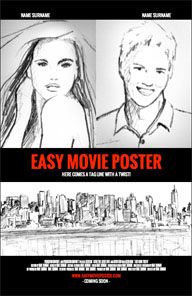Reel Artistry: Unleashing AI's Magic to Create Stunning Movie Posters
Reel Artistry: Unleashing AI's Magic to Create Stunning Movie Posters
Blog Article

In the ever-evolving landscape of film marketing, the visual allure of a movie poster plays a pivotal role in capturing the audience's attention. As filmmakers and designers seek innovative ways to stand out in a crowded marketplace, the emergence of AI technology has introduced a groundbreaking tool: the AI movie poster generator. This powerful software not only streamlines the design process but also unleashes creativity that can transform any film concept into stunning visual art.
Gone are the days when crafting a captivating poster required extensive design skills and resources. With AI movie poster generators, filmmakers can harness the magic of artificial intelligence to generate eye-catching images that reflect the essence of their stories. This technology analyzes styles, themes, and elements from existing movie posters, creating unique designs that resonate with potential viewers. As we delve into the world of AI-generated movie posters, we explore how this tool is reshaping the way films are marketed and how it empowers creativity in the cinematic realm.
The Evolution of Movie Posters
The journey of movie posters began in the late 19th century when silent films started gaining popularity. At that time, posters were simple and often featured a single image along with the film's title. These early designs were painted by hand, emphasizing the artistry involved in capturing the essence of a film in just one frame. As the film industry grew, so did the creativity behind these promotional tools, transforming them into essential elements of movie marketing.
As sound films emerged in the 1930s, the complexity of movie posters expanded significantly. Artists began experimenting with typography, incorporating bold graphics, and using vivid colors to attract audiences. Famous artists such as Saul Bass and Drew Struzan came to the forefront, creating iconic images that would become synonymous with the films themselves. This era marked the beginning of posters that not only advertised films but also became collectible pieces of art, reflecting the culture and aesthetics of their time.
With the advent of digital technology, the design of movie posters entered a new phase in the late 20th and early 21st centuries. Graphic design software allowed for unprecedented creative freedom, enabling designers to manipulate images and create intricate designs easily. The rise of social media and online marketing has further transformed the landscape, as audiences are now presented with posters in various formats and styles. Today, innovative technologies, including AI movie poster generators, are revolutionizing how these posters are created, allowing for a blend of creativity and technology that enhances visual storytelling even further.
How to generate eye-catching movie posters
How AI Transforms Poster Design
AI technology is revolutionizing the way movie posters are crafted, offering a new level of creativity and efficiency. Traditionally, the design process involved extensive brainstorming sessions, manual sketching, and multiple revisions. With AI movie poster generators, designers can rapidly generate a variety of concepts based on input parameters, drastically reducing the time it takes to arrive at compelling visuals. These tools can analyze trends, styles, and audience preferences, enabling designers to create targeted artwork that resonates with viewers.
Furthermore, AI brings a unique collaborative element to poster design. By harnessing machine learning algorithms, these generators can interpret the artistic styles of past successful posters and integrate similar aesthetics into new designs. This means that even those who may not have formal training in graphic design can produce professional-looking posters by simply inputting keywords or themes. The accessibility of AI in this field allows for a diverse range of voices and ideas to emerge, fostering innovation within movie marketing.
Finally, AI's ability to experiment with colors, fonts, and layouts in real time empowers designers to explore options they may not have considered otherwise. The instant feedback loop provided by AI tools encourages creative risk-taking, as designers can see how different elements impact the overall feel of the poster. This synergy between human creativity and AI capabilities not only enhances the artistic process but also leads to the creation of stunning posters that effectively capture the essence of the films they represent.
Future Trends in AI-Generated Art
As technology continues to evolve, the capabilities of AI in generating art, particularly movie posters, are expected to expand significantly. Future AI movie poster generators will likely harness advanced machine learning techniques that analyze vast datasets of artistic styles and trends. This will enable them to produce not just visually stunning images, but also tailored designs that reflect contemporary aesthetics and themes relevant to the target audience. The integration of emotional intelligence into AI could allow these generators to create posters that resonate more deeply with viewers, enhancing the connection between the artwork and its audience.
Collaboration between AI and human artists will also play a vital role in shaping the future of movie poster design. Instead of replacing human creativity, AI tools will serve as collaborators, enhancing the artistic process. Filmmakers and designers may use AI-generated concepts as starting points, blending human intuition and experience with AI efficiency. This symbiotic relationship could lead to unique poster designs that embody both technical precision and artistic flair, ultimately enriching the visual landscape of film marketing.
Moreover, the rise of personalized and interactive content will influence AI-generated art in movie posters. As audiences become more engaged with media, there will be an increasing demand for customization and interactivity. Future AI systems may allow users to input their preferences or even alter aspects of the poster in real-time. This shift towards interactivity could transform the way film promotions are executed, making movie posters not only promotional tools but engaging artifacts that invite audience participation.
Report this page